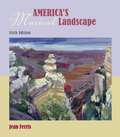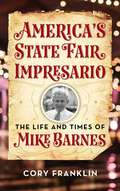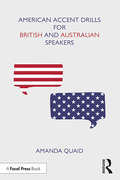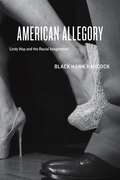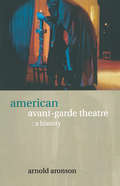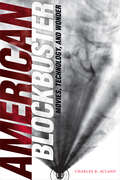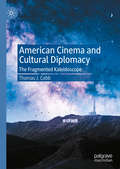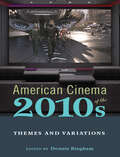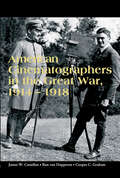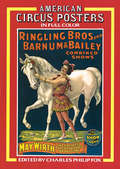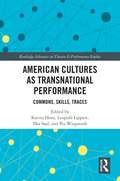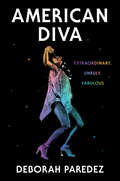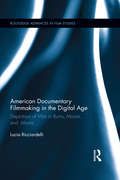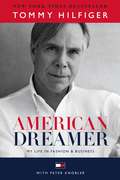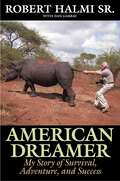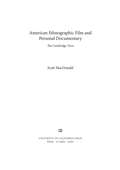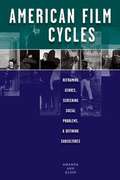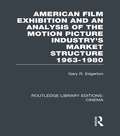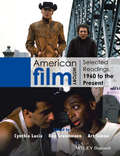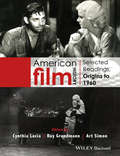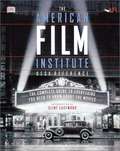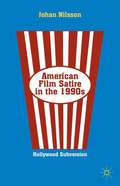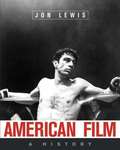- Table View
- List View
America's Musical Landscape
by Jean FerrisThis textbook for music appreciation undergraduates surveys American music, relating it to the other arts and social and cultural contexts. Ferris (music history and appreciation, Arizona State U.) first explains the elements of music, then takes the reader on a chronological tour of American music, from North American Indian and folk music to contemporary mainstream concert music. Along the way, religious and secular music are discussed, as well as nineteenth century popular and concert music; country, folk, jazz, Latin music, and rock and roll; and musical theater, film music, and American opera. Listening charts are incorporated. This edition has been updated and reorganized, the amount of vernacular music has been expanded, and the recordings have been updated to match. Timelines are also new. No bibliography is provided. Annotation ©2006 Book News, Inc., Portland, OR (booknews.com)
America's State Fair Impresario: The Life and Time of Mike Barnes
by Cory M. FranklinBorn in poverty in 19th century New York City, Mike Barnes rose to become America&’s premiere 20th century American show fair impresario, who embodied the Irving Berlin lyric, &“There&’s no business like show business.&” For four decades, he presented dramatic spectacles worthy of Cecil B. DeMille, musical and dancing revues that rivaled anything by Busby Berkeley, animal acts, daredevil wing walkers, human cannonballs, flagpole sitters and auto demolitions. He assembled and directed these acts, entertaining millions across the United States, even during times of depression and world war. His influence on outdoor lighting and sound system presentation is still felt today in 21st century outdoor performances. Besides a snapshot of midcentury America, America&’s State Fair Impresario:The Life & Times of Mike Barnes is the story of a modest man who was a brilliant showman, shrewd businessman, philanthropist, and exemplary family man. In short, a legendary American.
America, As Seen on TV: How Television Shapes Immigrant Expectations around the Globe
by Clara E. RodríguezFinalist, 2020 Latino Book Awards, Best Academic Themed BookThe surprising effects of American TV on global viewers As a dominant cultural export, American television is often the first exposure to American ideals and the English language for many people throughout the world. Yet, American television is flawed, and, it represents race, class, and gender in ways that many find unfair and unrealistic. What happens, then, when people who grew up on American television decide to come to the United States? What do they expect to find, and what do they actually find? In America, As Seen on TV, Clara E. Rodríguez surveys international college students and foreign nationals working or living in the US to examine the impact of American television on their views of the US and on their expectations of life in the United States. She finds that many were surprised to learn that America is racially and economically diverse, and that it is not the easy-breezy, happy endings culture portrayed in the media, but a work culture. The author also surveys US-millennials about their consumption of US TV and finds that both groups share the sense that American TV does not accurately reflect racial/ethnic relations in the US as they have experienced them. However, the groups differ on how much they think US TV has influenced their views on sex, smoking and drinking. America, As Seen on TV explores the surprising effects of TV on global viewers and the realities they and US millennials actually experience in the US.
American Accent Drills for British and Australian Speakers
by Amanda QuaidAmerican Accent Drills for British and Australian Speakers provides a comprehensive guide to learning a "General American" accent, made specifically for native English speakers. Unlike most American accent guides, which are geared toward ESL learners, this handbook covers only the shifts that English speakers need to make – nothing more, nothing less. In addition to vowel and consonant drills, it covers the finer points of American intonation and elision, features that often elude English speakers of other dialects. Finally, it provides exercises for "owning" the dialect, finding authenticity and making it work for each individual actor in their own way. This is an excellent resource for students of speech and dialects, actors from the UK, Australia, and New Zealand, and advanced ESL learners who need to use an American accent on screen or on stage. American Accent Drills for British and Australian Speakers also includes access to downloadable audio files of the practice drills featured in the book, to help students practice and perfect their American accent.
American Allegory: Lindy Hop and the Racial Imagination
by Black Hawk HancockOC Perhaps, OCO wrote Ralph Ellison more than seventy years ago, OC the zoot suit contains profound political meaning; perhaps the symmetrical frenzy of the Lindy-hop conceals clues to great potential power. OCO As Ellison noted then, many of our most mundane cultural forms are larger and more important than they appear, taking on great significance and an unexpected depth of meaning. What he saw in the power of the Lindy HopOCothe dance that "Life "magazine once billed as OC AmericaOCOs True National Folk DanceOCOOCowould spread from black America to make a lasting impression on white America and offer us a truly compelling means of understanding our culture. But with what hidden implications? In "American Allegory," Black Hawk Hancock offers an embedded and embodied ethnography that situates dance within a larger Chicago landscape of segregated social practices. Delving into two Chicago dance worlds, the Lindy and SteppinOCO, Hancock uses a combination of participant-observation and interviews to bring to the surface the racial tension that surrounds white use of black cultural forms. Focusing on new forms of appropriation in an era of multiculturalism, Hancock underscores the institutionalization of racial disparities and offers wonderful insights into the intersection of race and culture in America.
American Avant-Garde Theatre: A History (Theatre Production Studies)
by Arnold AronsonThis stunning contribution to the field of theatre history is the first in-depth look at avant-garde theatre in the United States from the early 1950s to the 1990s. American Avant-Garde Theatre offers a definition of the avant-garde, and looks at its origins and theoretical foundations by examining: *Gertrude Stein *John Cage *The Beat writers *Avant-garde cinema *Abstract Expressionism *Minimalism There are fascinating discussions and illustrations of the productions of the Living Theatre, the Wooster Group, Open Theatre, Ontological-Hysteric Theatre and Performance Group. among many others. Aronson also examines why avant-garde theatre declined and virtually disappeared at the end of the twentieth century.
American Blockbuster: Movies, Technology, and Wonder (Sign, Storage, Transmission)
by Charles R. AclandBen-Hur (1959), Jaws (1975), Avatar (2009), Wonder Woman (2017): the blockbuster movie has held a dominant position in American popular culture for decades. In American Blockbuster Charles R. Acland charts the origins, impact, and dynamics of this most visible, entertaining, and disparaged cultural form. Acland narrates how blockbusters emerged from Hollywood's turn to a hit-driven focus during the industry's business crisis in the 1950s. Movies became bigger, louder, and more spectacular. They also became prototypes for ideas and commodities associated with the future of technology and culture, accelerating the prominence of technological innovation in modern American life. Acland shows that blockbusters continue to be more than just movies; they are industrial strategies and complex cultural machines designed to normalize the ideologies of our technological age.
American Cinema and Cultural Diplomacy: The Fragmented Kaleidoscope
by Thomas J. CobbThis book contends that Hollywood films help illuminate the incongruities of various periods in American diplomacy. From the war film Bataan to the Revisionist Western The Wild Bunch, cinema has long reflected US foreign policy’s divisiveness both directly and allegorically. Beginning with the 1990s presidential drama The American President and concluding with Joker’s allegorical treatment of the Trump era, this book posits that the paradigms for political reflection are shifting in American film, from explicit subtexts surrounding US statecraft to covert representations of diplomatic disarray. It further argues that the International Relations theorist Walter Mead’s concept of a US polity dominated by contesting beliefs, or a ‘kaleidoscope’, permeates these changing paradigms. This synergy reveals a cultural milieu where foreign policy fissures are increasingly encoded by cinematic representation. The interdisciplinarity of this focus renders this book pertinent reading for scholars and students of American Studies, Film Studies and International Relations, along with those generally interested in Hollywood filmmakers and foreign policy.
American Cinema of the 2010s: Themes and Variations (Screen Decades: American Culture/American Cinema)
by Cynthia Baron David Greven Julie Levinson Daniel Smith-Rowsey Lisa Bode Alexandra Keller Michele Schreiber Raymond Haberski Jr. Dennis Bingham Mikal J. GainesThe 2010s might be remembered as a time of increased polarization in American life. The decade contained both the Obama era and the Trump era, and as the nation’s political fissures widened, so did the gap between the haves and have-nots. Hollywood reflected these divisions, choosing to concentrate on big franchise blockbusters at the expense of mid-budget films, while new players like Netflix and Amazon offered fresh opportunities for low-budget and independent filmmakers. As the movie business changed, films ranging from American Sniper to Get Out found ways to speak to the concerns of a divided nation. The newest installment in the Screen Decades series, American Cinema in the 2010s takes a close look at the memorable movies, visionary filmmakers, and behind-the-scenes drama that made this decade such an exciting time to be a moviegoer. Each chapter offers an in-depth examination of a specific year, covering a wide variety of films, from blockbuster superhero movies like Black Panther and animated films like Frozen to smaller-budget biopics like I, Tonya and horror films like Hereditary. This volume introduces readers to a decade in which established auteurs like Quentin Tarantino were joined by an exceptionally diverse set of new talents, taking American cinema in new directions.
American Cinematographers in the Great War, 1914–1918
by James W. Castellan Ron van Dopperen Copper C. GrahamA history of American cameramen covering the news of World War I, from the dangerous front line and the risk of execution to red tape and censorship.At the start of hostilities in World War I, when the United States was still neutral, American newsreel companies and newspapers sent a new kind of journalist, the film correspondent, to Europe to record the Great War. These pioneering cameramen, accustomed to carrying the Kodaks and Graflexes of still photography, had to lug cumbersome equipment into the trenches. Facing dangerous conditions on the front, they also risked summary execution as supposed spies while navigating military red tape, censorship, and the business interests of the film and newspaper companies they represented. Based on extensive research in European and American archives, American Cinematographers in the Great War, 1914–1918 follows the adventures of these cameramen as they managed to document and film the atrocities around them in spite of enormous difficulties.“The first book to explore the work and working conditions of American cinematographers active on the different fronts of the First World War. It is a pioneering study which has already attracted a good deal of attention in the academic and archive world.” —Historical Journal of Film, Radio and Television
American Circus Posters
by Charles Philip FoxThe Children's Dream of Fairy-Land (1893) . . . Living Statues on Horseback (1890s) . . . Real Roman Hippodrome, Five Continent Menagerie (1890s) . . . Uno, Queen Supreme of the Serpent Kingdom (1894) . . . Dancing Girls, Mounted Guards and Truly Lavish Displays (1903) . . . "Twisting Double Somersault," A Feat Never Before Attempted by the Most Intrepid Aerialists (1904) . . . Desperado's Terrible Leap for Life, A Terrific Descent of 80 Feet Through Space Landing Upon His Chest on a Skid (1909) . . . The Imperial Chinese Circus Stars (1914) . . . An Army of Clowns (1920s) . . . Pallenberg's Wonder Bears (1920s) . . . Gargantua the Great (1938).Originally put in store windows and posted on sheds, barns, buildings, walls and fences, these 18 extremely rare posters, most not previously reproduced, are collected together for the first time. The quality of reproduction is superb: reproduced in full color directly from the originals, these posters have been printed in an extra large format and on coated stock so that every detail is clear. They are an exciting visual history, capturing the pageantry and color that the circus was and is. They are also extremely fine examples of almost 50 years of poster art and American advertising. There are acrobats, elephants, tigers, lions, parades, tents, trains, and many specialized acts: May Wirth, the Riding Rooneys, the Astounding Clarkonians, etc. The posters date from the 1890s to the 1940s, and include one by Norman Bel Geddes. They feature many American circuses: Ringling Bros., Barnum & Bailey, Sells, Sparks, Hagenbeck-Wallace. The historical introduction and captions are by Charles Philip Fox, Director of Research and Development with the Ringling Bros. and Barnum & Bailey Circus.
American Cocktail
by George Hutchinson Anita Reynolds Howard M. MillerThis is the rollicking, never-before-published memoir of a fascinating woman with an uncanny knack for being in the right place in the most interesting times. Of racially mixed heritage, Anita Reynolds was proudly African American but often passed for Indian, Mexican, or Creole. Actress, dancer, model, literary critic, psychologist, but above all free-spirited provocateur, she was, as her Parisian friends nicknamed her, an "American cocktail. " One of the first black stars of the silent era, she appeared in Hollywood movies with Rudolph Valentino, attended Charlie Chaplin's anarchist meetings, and studied dance with Ruth St. Denis. She moved to New York in the 1920s and made a splash with both Harlem Renaissance elites and Greenwich Village bohemians. An emigre in Paris, she fell in with the Left Bank avant garde, " befriending Antonin Artaud, Man Ray, and Pablo Picasso. Next, she took up residence as a journalist in Barcelona during the Spanish Civil War and witnessed firsthand the growing menace of fascism. In 1940, as the Nazi panzers closed in on Paris, Reynolds spent the final days before the French capitulation as a Red Cross nurse, afterward making a mad dash for Lisbon to escape on the last ship departing Europe. In prose that perfectly captures the globetrotting nonchalance of its author, American Cocktail" presents a stimulating, unforgettable self-portrait of a truly extraordinary woman.
American Cultures as Transnational Performance: Commons, Skills, Traces (Routledge Advances in Theatre & Performance Studies)
by Katrin Horn Ilka Saal Pia Wiegmink Leopold LippertThis book investigates transnational processes through the analytic lens of cultural performance. Structured around key concepts of performance studies––commons, skills, and traces––this edited collection addresses the political, normative, and historical implications of cultural performances beyond the limits of the (US) nation-state. These three central aspects of performance function as entryways to inquiries into transnational processes and allow the authors to shift the discussion away from text-centered approaches to intercultural encounters and to bring into focus the dynamic field that opens up between producer, art work, context, setting, and audience in the moment of performance as well as in its afterlife. The chapters provide fresh, performance-based approaches to notions of transcultural mobility and circulation, transnational cultural experience and knowledge formation, transnational public spheres, and identities’ rootedness in both specific local places and diasporic worlds beyond the written word. This book will be of great interest to scholars and students of American studies, performance studies, and transnational studies
American Diva: Extraordinary, Unruly, Fabulous
by Deborah ParedezAn impassioned homage to the divas who shake up our world and transform it with their bold, dazzling artistry. What does it mean to be a “diva”? A shifting, increasingly loaded term, it has been used to both deride and celebrate charismatic and unapologetically fierce performers like Aretha Franklin, Divine, and the women of Labelle. In this brilliant, powerful blend of incisive criticism and electric memoir, Deborah Paredez—scholar, cultural critic, and lifelong diva devotee—unravels our enduring fascination with these icons and explores how divas have challenged American ideas about feminism, performance, and freedom. American Diva journeys into Tina Turner’s scintillating performances, Celia Cruz’s command of the male-dominated salsa world, the transcendent revival of Jomama Jones after a period of exile, and the unparalleled excellence of Venus and Serena Williams. Recounting how she and her mother endlessly watched Rita Moreno’s powerhouse portrayal of Anita in West Side Story and how she learned much about being bigger than life from her fabulous Tía Lucia, Paredez chronicles the celebrated and skilled performers who not only shaped her life but boldly expressed the aspiration for freedom among brown, Black, and gay communities. Paredez also traces the evolution of the diva through the decades, dismayed at the mid-aughts’ commodification and juvenilizing of its meaning but finding its lasting beauty and power. Filled with sharp insights and great heart, American Diva is a spirited tribute to the power of performance and the joys of fandom.
American Documentary Filmmaking in the Digital Age: Depictions of War in Burns, Moore, and Morris (Routledge Advances in Film Studies)
by Lucia RicciardelliAmerican Documentary Filmmaking in the Digital Age examines the recent challenges to the conventions of realist documentary through the lens of war documentary films by Ken Burns, Michael Moore, and Errol Morris. During the twentieth century, the invention of new technologies of audiovisual representation such as cinema, television, video, and digital media have transformed the modes of historical narration and with it forced historians to assess the impact of new visual technologies on the construction of history. This book investigates the manner in which this contemporary Western "crisis" in historical narrative is produced by a larger epistemological shift in visual culture. Ricciardelli uses the theme of war as depicted in these directors’ films to focus her study and look at the model(s) of national identity that Burns, Morris, and Moore shape through their depictions of US military actions. She examines how postcolonial critiques of historicism and the advent of digitization have affected the narrative structure of documentary film and the shaping of historical consciousness through cinematic representation.
American Dreamer: My Life in Fashion & Business
by Quincy Jones Peter Knobler Tommy HilfigerIn this tale of grit and glamour, setbacks and comebacks, business and pop culture icon Tommy Hilfiger shares his extraordinary life story for the first time. Few designers have stayed on top of changing trends the way Tommy Hilfiger has. Fewer still have left such an indelible mark on global culture. Since designing his first collection of "classics with a twist" three decades ago, Tommy Hilfiger has been synonymous with all-American style--but his destiny wasn't always so clear. Growing up one of nine children in a working-class family in Elmira, New York, Tommy suffered from dyslexia, flunked sophomore year of high school, and found himself constantly at odds with his father. Nevertheless, this self-described dreamer had a vision and the relentless will to make it a reality. At eighteen he opened his own clothing store, parlaying his uncanny instinct for style into a budding career as a fashion designer. Through decades of triumph and turmoil, Tommy remained doggedly optimistic. To this day, his approach to commerce is rooted in his positive view of the world.American Dreamer brims with anecdotes that cover Tommy's years as a club kid and scrappy entrepreneur in 1970s New York as well as unique insights into the exclusive A-list personalities with whom he's collaborated and interacted, from Mick Jagger and David Bowie to Ralph Lauren and Calvin Klein. But this is more than just a fashion icon's memoir--it's a road map for building a brand, both professionally and personally. Tommy takes us behind the scenes of every decision--and every mistake--he's ever made, offering advice on leadership, business, team-building, and creativity. This is the story of a true American original, told for the first time in his own words, with honesty, humor, and the insatiable appetite for life and style that proves that sometimes you have to dream big to make it big. Advance praise for American Dreamer "Tommy burst onto the fashion scene at the height of hip-hop and was instantly taken up by rappers and rockers alike. Since then, year after year he has been ahead of the curve with his elegant and stylish looks. His creative energy has always been an inspiration to me. He's really himself in American Dreamer."--Mick Jagger "Whenever I think of Tommy Hilfiger, I think of a designer who has been able to wrap fashion in the American flag. In American Dreamer Tommy shows how he has taken the (rock) stars and the (preppy) stripes and come up with a look--and a label--that are recognized globally as being quintessentially American, as well as a brand that constantly keeps time with pop music."--Anna Wintour "Tommy is an inspiration to many people. American Dreamer shows how he has managed to be successful in business and done so with integrity. I have come to know Tommy, and every time we talk I learn something new about creating a successful business."--David Beckham "Tommy is one of the most genuine people I know! In American Dreamer you can feel his passion pour through everything he does: fashion, fatherhood, family, and friendship!"--Alicia Keys "Tommy Hilfiger is an American icon who was able to transcend fashion and blend it with pop culture and take it to a worldwide audience. American Dreamer documents how, unlike any other designer, Tommy was able to tap into music, its subculture, and its influence on society, which propelled his fashion to be mainstream and global."--Tommy MottolaFrom the Hardcover edition.
American Dreamer: My Story of Survival, Adventure, and Success
by Robert HalmiOn July 30, 2014, shortly after completing this autobiography, Robert Halmi, the prolific producer of television movies and miniseries, died at the age of 90. Hailed by Variety as &“A Gulliver Among TV Movie Producers,&” he had a hand in more than 200 long-form narrative television projects from 1989&’s Lonesome Dove, starring Robert Duvall, to 2000&’s &“Don Quixote&” starring John Lithgow. Filled with so much of the marquee talent of the past century, his life story—from fighting against the Nazis to becoming a photographer for Life and Sports Illustrated to his television work—is truly amazing.Robert Halmi was born in Hungary to a father who served as official photographer to the Vatican and the last Habsburg court. When the Nazis invaded, he fought in the resistance, and like many of his countrymen he was captured and condemned to death. But the advancing Red Army freed him before the Germans could carry out the execution. Seeing the dangers of the expanding Soviet empire, which also took hold of his homeland in a military dictatorship, he turned heel and joined the OSS to fight the fall of the Iron Curtain. In 1951, with $5 in his pocket and a Leica around his neck, he made his way to America. As a photographer for Life and Sports Illustrated, he again showcased his Bond-like talents for chasing adventure and cheating death by dangling from helicopters, hunting big game in Africa with dictators, blowing himself up, marooning himself on a glacier for three weeks, and even painting Marilyn Monroe&’s naked body for a photo shoot. In the third act of his rollicking life, as a TV mogul, he received an astonishing 448 Emmy nods while befriending a Who&’s Who of Hollywood and working with the great boldface actors of our time: Jimmy Cagney gave him his last performance. He chased George C. Scott (on a bender) through a hotel. Omar Sharif did the Twist for him. He watched Patrick Stewart nearly drown on the back of an animatronic whale, and Isabella Rossellini braved a herd of rampaging elephants for him. He has lived the American dream to the hilt. A fast-paced look back at a life always in progress, his extraordinary story reveals nearly a century of daring and boundless optimism even in the face of terrible odds. It&’s a story of war, love, and ambition, the quintessential American tale of a life lived large.
American Ethnographic Film and Personal Documentary
by Scott MacdonaldAmerican Ethnographic Film and Personal Documentary is a critical history of American filmmakers crucial to the development of ethnographic film and personal documentary. The Boston and Cambridge area is notable for nurturing these approaches to documentary film via institutions such as the MIT Film Section and the Film Study Center, the Carpenter Center and the Visual and Environmental Studies Department at Harvard. Scott MacDonald uses pragmatism's focus on empirical experience as a basis for measuring the groundbreaking achievements of such influential filmmakers as John Marshall, Robert Gardner, Timothy Asch, Ed Pincus, Miriam Weinstein, Alfred Guzzetti, Ross McElwee, Robb Moss, Nina Davenport, Steve Ascher and Jeanne Jordan, Michel Negroponte, John Gianvito, Alexander Olch, Amie Siegel, Ilisa Barbash, and Lucien Castaing-Taylor. By exploring the cinematic, personal, and professional relationships between these accomplished filmmakers, MacDonald shows how a pioneering, engaged, and uniquely cosmopolitan approach to documentary developed over the past half century.
American Film Cycles
by Amanda Ann KleinA series of movies that share images, characters, settings, plots, or themes, film cycles have been an industrial strategy since the beginning of cinema. While some have viewed them as “subgenres,” mini-genres, or nascent film genres, Amanda Ann Klein argues that film cycles are an entity in their own right and a subject worthy of their own study. She posits that film cycles retain the marks of their historical, economic, and generic contexts and therefore can reveal much about the state of contemporary politics, prevalent social ideologies, aesthetic trends, popular desires, and anxieties. American Film Cycles presents a series of case studies of successful film cycles, including the melodramatic gangster films of the 1920s, the 1930s Dead End Kids cycle, the 1950s juvenile delinquent teenpic cycle, and the 1990s ghetto action cycle. Klein situates these films in several historical trajectories—the Progressive movement of the 1910s and 1920s, the beginnings of America’s involvement in World War II, the “birth” of the teenager in the 1950s, and the drug and gangbanger crises of the early 1990s. She shows how filmmakers, audiences, film reviewers, advertisements, and cultural discourses interact with and have an impact on the film texts. Her findings illustrate the utility of the film cycle in broadening our understanding of established film genres, articulating and building upon beliefs about contemporary social problems, shaping and disseminating deviant subcultures, and exploiting and reflecting upon racial and political upheaval.
American Film Exhibition and an Analysis of the Motion Picture Industry's Market Structure 1963-1980 (Routledge Library Editions: Cinema)
by Gary EdgertonThis study looks at how the movie industry organisation functioned between the late ‘40s and 1983 when it was originally published. It describes the changing role of domestic exhibition through this time and analyses the wider film industry to provide a model of the exhibition structure in relation to production, distribution and outside factors. It addresses the growing issues of the cable and video markets as competition to the film exhibition business at that time and looks forward into a highly turbulent environment. With particular interest now as the film industry address a new range of threats and adaptations of its working structure, this book offers and integral understanding of a key stage in cinema history.
American Film History: Selected Readings, 1960 to the Present
by Cynthia Lucia Roy Grundmann Art SimonFrom the American underground film to the blockbuster superhero, this authoritative collection of introductory and specialized readings explores the core issues and developments in American cinematic history during the second half of the twentieth-century through the present day. Considers essential subjects that have shaped the American film industry—from the impact of television and CGI to the rise of independent and underground film; from the impact of the civil rights, feminist and LGBT movements to that of 9/11. Features a student-friendly structure dividing coverage into the periods 1960-1975, 1976-1990, and 1991 to the present day, each of which opens with an historical overview Brings together a rich and varied selection of contributions by established film scholars, combining broad historical, social, and political contexts with detailed analysis of individual films, including Midnight Cowboy, Nashville, Cat Ballou, Chicago, Back to the Future, Killer of Sheep, Daughters of the Dust, Nothing But a Man, Ali, Easy Rider, The Conversation, The Texas Chain Saw Massacre, Longtime Companion, The Matrix, The War Tapes, the Batman films, and selected avant-garde and documentary films, among many others. Additional online resources, such as sample syllabi, which include suggested readings and filmographies, for both general and specialized courses, will be available online. May be used alongside American Film History: Selected Readings, Origins to 1960 to provide an authoritative study of American cinema from its earliest days through the new millennium
American Film History: Selected Readings, Origins to 1960
by Cynthia Lucia Roy Grundmann Art SimonThis authoritative collection of introductory and specialized readings explores the rich and innovative history of this period in American cinema. Spanning an essential range of subjects from the early 1900s Nickelodeon to the decline of the studio system in the 1960s, it combines a broad historical context with careful readings of individual films. Charts the rise of film in early twentieth-century America from its origins to 1960, exploring mainstream trends and developments, along with topics often relegated to the margins of standard film histories Covers diverse issues ranging from silent film and its iconic figures such as Charlie Chaplin, to the coming of sound and the rise of film genres, studio moguls, and, later, the Production Code and Cold War Blacklist Designed with both students and scholars in mind: each section opens with an historical overview and includes chapters that provide close, careful readings of individual films clustered around specific topics Accessibly structured by historical period, offering valuable cultural, social, and political contexts Contains careful, close analysis of key filmmakers and films from the era including D.W. Griffith, Charles Chaplin, Buster Keaton, Erich von Stroheim, Cecil B. DeMille, Don Juan, The Jazz Singer, I Am a Fugitive from a Chain Gang, Scarface, Red Dust, Glorifying the American Girl, Meet Me in St. Louis, Citizen Kane, Bambi, Frank Capra’s Why We Fight series, The Strange Love of Martha Ivers, Rebel Without a Cause, Force of Evil, and selected American avant-garde and underground films, among many others. Additional online resources such as sample syllabi, which include suggested readings and filmographies for both general specialized courses, will be available online. May be used alongside American Film History: Selected Readings, 1960 to the Present, to provide an authoritative study of American cinema through the new millennium
American Film Institute Desk Reference
by George Ochoa Melinda CoreyThe American Film Institute Desk Reference is the most comprehensive book on filmmaking. It provides detailed information on the world of film, its history and its personalities.
American Film Satire in the 1990s
by Johan NilssonSatire is often defined as a moral and rhetorical art that engages in social critique through wit and ridicule. During its long history it has come in many forms and genres as well as in different types of media (verse, drama, rhetorical performance, prose, cartoons, journalism, film, TV, internet). Here, Nilsson examines American film satire produced during the 1990s and how its style and form cue viewers towards constructing satirical meaning. The study offers an explanation for how a particular selection of films turned material circulating in American culture of the 1990s into satirical experiences for viewers and finds that there are elements of resistance to mainstream culture in the original material: resistance to norms and conventions in politics, to mainstream news channels and Hollywood, and to official American history.
American Film: A History
by Jon Lewis<p>Written by a top scholar in the field, American Film: A History gives students a thorough understanding of the fascinating intersection of artistry and economics in Hollywood cinema from the beginning of film history to the present. <p>A beautiful book and a brisk read, American Film is the most enjoyable and interesting overview of the history of American filmmaking available. Focused on aspects of the film business that are of perennial interest to undergraduates, this book will engage students from beginning to end.</p>
